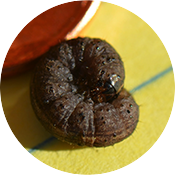The risk of crop loss due to black cutworm (BCW) cut plants varies greatly from year to year. The black cutworm can’t survive winters in Minnesota or other latitudes with freezing winter temperatures. In these areas, migrant moths produce annual infestations each spring. Yield-limiting Infestations depend on when, where, and how many, moths arrive from the south with respect to spring tillage and planting or susceptible crops.
The Minnesota Black Cutworm Reporting Network consists of a group of volunteers throughout the state that set pheromone traps to help monitor black cutworm migrations into the state. Volunteer trappers this year are checking traps daily and reporting their observations once a week. Female BCW moths release a unique chemical compound (pheromone) to attract males. The BCW pheromone trap includes a small lure impregnated with a synthetic version of this pheromone. Unfortunate male moths, mistaking the odors wafting from the trap for an unmated female, fly into the trap where the trap’s sticky bottom captures them. Only BCW moths react to the pheromone and then, only for the few days after migrants arrive and complete mating.
This species-specificity and narrow capture window allows us to use these trap captures to locate when and where large flights of BCW migrate into Minnesota. This information helps us predict areas of Minnesota where corn, sugarbeets and other crops are at higher risk from damage, when crop injury will begin and just as importantly when cutting will stop.
This network is supported, in part, by the farm families of Minnesota and their corn check-off investment.
Black Cutworm Resources
- Black Cutworm Facts (website)
- Black Cutworm Facts (PDF)
- Instructions for monitoring and reporting black cutworm pheromone traps
2024 UMN Cooperative Black Cutworm Trapping Network Reports
Black Cutworm Reporting Network Archive
Archived versions of the UMN Cooperative Black Cutworm Trapping Network Reports are available in pdf format on the University of Minnesota's Digital Conservancy:
- 2023 BCW Reporting Newtork Newsletters
- 2022 BCW Reporting Network Newsletters
- 2021 BCW Reporting Network Newsletters
- 2020 BCW Reporting Network Newsletters
- 2019 BCW Reporting Network Newsletters
- 2018 BCW Reporting Network Newsletters
- 2017 BCW Reporting Network Newsletters
- 2016 BCW Reporting Network Newsletters
- 2015 BCW Reporting Network Newsletters
- 2014 BCW Reporting Network Newsletters
- 2013 BCW Reporting Network Newsletters

